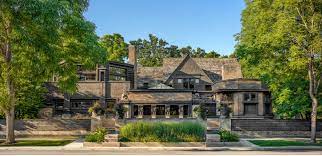Frank Lloyd Wright: A Pioneer of Modern Architecture

Frank Lloyd Wright: A Pioneer of Modern Architecture
Frank Lloyd Wright is one of the most celebrated architects of the 20th century. Born in Wisconsin in 1867, he is known for his innovative and unique designs that revolutionized modern architecture.
Wright’s architectural career spanned over 70 years and included more than 1,000 completed projects, including private homes, public buildings, and commercial spaces. He was a pioneer of the Prairie School movement, which emphasized horizontal lines and integration with the surrounding landscape.
One of Wright’s most famous works is the Fallingwater house in Pennsylvania. Built in 1935 for a wealthy family, the house is built over a waterfall and features cantilevered balconies that seem to float above the water. The design is an excellent example of Wright’s philosophy of “organic architecture,” which sought to create buildings that were in harmony with their natural surroundings.
Another iconic Wright building is the Guggenheim Museum in New York City. Completed in 1959, it features a unique spiral design that allows visitors to view artwork while walking up a ramp. The museum’s circular shape also creates an intimate viewing experience and allows for natural light to filter into the space.
Wright was not only known for his architectural designs but also for his furniture designs. He believed that furniture should be designed specifically for each space and often created custom pieces for his clients’ homes.
Despite his many successes, Wright faced several challenges throughout his career. He was known for being difficult to work with and had several high-profile projects that were never completed due to disagreements with clients or lack of funding.
Wright also faced personal tragedies, including the murder of his mistress and her children by one of his employees at his home, Taliesin East.
Today, Frank Lloyd Wright’s legacy lives on through his buildings and designs. Many of his works have been designated as National Historic Landmarks or are listed on the National Register of Historic Places. His influence can also be seen in the work of many contemporary architects who continue to push the boundaries of modern architecture.
In conclusion, Frank Lloyd Wright was a visionary who helped shape modern architecture with his innovative designs and philosophy of organic architecture. His legacy continues to inspire and influence architects around the world, and his buildings remain some of the most beloved and iconic structures in history.
5 Common Questions About Frank Lloyd Wright’s Life and Architecture
- What is the most famous work of Frank Lloyd Wright?
- When did Frank Lloyd Wright live?
- Where did Frank Lloyd Wright study architecture?
- What style of architecture did Frank Lloyd Wright use?
- How many buildings did Frank Lloyd Wright design in his lifetime?
What is the most famous work of Frank Lloyd Wright?
One of Frank Lloyd Wright’s most famous works is the Fallingwater house, also known as the Kaufmann Residence. Built in 1935 in southwestern Pennsylvania, the house is a prime example of Wright’s philosophy of “organic architecture,” which emphasized harmony between the built environment and natural surroundings. The house is built over a waterfall and features cantilevered balconies that seem to float above the water. It has become an iconic symbol of modern architecture and is considered one of Wright’s greatest masterpieces.
When did Frank Lloyd Wright live?
Frank Lloyd Wright was born on June 8, 1867, and he died on April 9, 1959. He lived for 91 years.
Where did Frank Lloyd Wright study architecture?
Frank Lloyd Wright studied architecture at the University of Wisconsin-Madison for two semesters before dropping out. He then moved to Chicago and began working as a draftsman at an architectural firm, where he gained practical experience and developed his skills. He later worked as an apprentice to Louis Sullivan, a prominent architect who became a mentor to Wright and greatly influenced his work.
What style of architecture did Frank Lloyd Wright use?
Frank Lloyd Wright is known for his unique style of architecture, which is often referred to as “organic architecture.” This style emphasizes the relationship between buildings and their natural surroundings, with an emphasis on horizontal lines and open spaces. Wright’s designs often feature sweeping horizontal planes, cantilevered overhangs, and large windows that blur the boundary between indoor and outdoor spaces. He also incorporated natural materials such as wood, stone, and brick into his designs, further emphasizing the connection between buildings and nature. This style of architecture is closely associated with the Prairie School movement that developed in the early 20th century and was heavily influenced by Wright’s work.
How many buildings did Frank Lloyd Wright design in his lifetime?
Frank Lloyd Wright designed more than 1,000 buildings in his lifetime, including private homes, public buildings, and commercial spaces. Some of his most famous works include Fallingwater, the Guggenheim Museum, and the Robie House. He was also known for his furniture designs and philosophy of “organic architecture,” which sought to create buildings that were in harmony with their natural surroundings. Wright’s career spanned over 70 years and he remains one of the most celebrated architects of the 20th century.
